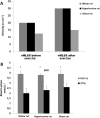Exercise induction of gut microbiota modifications in obese, non-obese and hypertensive rats
- PMID: 24952588
- PMCID: PMC4082611
- DOI: 10.1186/1471-2164-15-511
Exercise induction of gut microbiota modifications in obese, non-obese and hypertensive rats
Abstract
Background: Obesity is a multifactor disease associated with cardiovascular disorders such as hypertension. Recently, gut microbiota was linked to obesity pathogenesisand shown to influence the host metabolism. Moreover, several factors such as host-genotype and life-style have been shown to modulate gut microbiota composition. Exercise is a well-known agent used for the treatment of numerous pathologies, such as obesity and hypertension; it has recently been demonstrated to shape gut microbiota consortia. Since exercise-altered microbiota could possibly improve the treatment of diseases related to dysfunctional microbiota, this study aimed to examine the effect of controlled exercise training on gut microbial composition in Obese rats (n = 3), non-obese Wistar rats (n = 3) and Spontaneously Hypertensive rats (n = 3). Pyrosequencing of 16S rRNA genes from fecal samples collected before and after exercise training was used for this purpose.
Results: Exercise altered the composition and diversity of gut bacteria at genus level in all rat lineages. Allobaculum (Hypertensive rats), Pseudomonas and Lactobacillus (Obese rats) were shown to be enriched after exercise, while Streptococcus (Wistar rats), Aggregatibacter and Sutturella (Hypertensive rats) were more enhanced before exercise. A significant correlation was seen in the Clostridiaceae and Bacteroidaceae families and Oscillospira and Ruminococcus genera with blood lactate accumulation. Moreover, Wistar and Hypertensive rats were shown to share a similar microbiota composition, as opposed to Obese rats. Finally, Streptococcus alactolyticus, Bifidobacterium animalis, Ruminococcus gnavus, Aggregatibacter pneumotropica and Bifidobacterium pseudolongum were enriched in Obese rats.
Conclusions: These data indicate that non-obese and hypertensive rats harbor a different gut microbiota from obese rats and that exercise training alters gut microbiota from an obese and hypertensive genotype background.
Figures





References
-
- Global Recommendations on Physical Activity for Health. Geneva, Switzerland: WHO Library Cataloguing-in-Publication Data; 2010.
-
- Almeida JA BAP, Gomes CP, Araujo RC, Pereira RW, Franco OL. Exercise training at MLSS decreases weight gain and increases aerobic capacity in obese zucker rats. Int J Sports Med. 2014;35(3):199–202. - PubMed
Publication types
MeSH terms
LinkOut - more resources
Full Text Sources
Other Literature Sources

